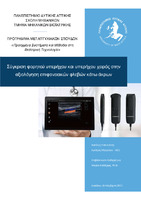| dc.contributor.advisor | Kallergi, Maria | |
| dc.contributor.author | Παπουτσής, Βασίλης | |
| dc.date.accessioned | 2021-10-08T10:46:20Z | |
| dc.date.available | 2021-10-08T10:46:20Z | |
| dc.date.issued | 2021-09 | |
| dc.identifier.uri | https://polynoe.lib.uniwa.gr/xmlui/handle/11400/1282 | |
| dc.identifier.uri | http://dx.doi.org/10.26265/polynoe-1133 | |
| dc.description.abstract | ΣΚΟΠΟΣ: Οι συσκευές υπερηχογραφίας αποτελούν, στις μέρες μας, αναπόσπαστο
διαγνωστικό εργαλείο ευρείας αποδοχής. Η παρούσα εργασία πραγματεύεται τη
σύγκριση ενός φορητού υπερήχου με έναν υπέρηχο χειρός, στη διάγνωση της φλεβικής
ανεπάρκειας των κάτω άκρων.
ΥΛΙΚΑ ΚΑΙ ΜΕΘΟΔΟΛΟΓΙΑ: Για την υλοποίηση της μελέτης χρησιμοποιήθηκαν δύο
συσκευές υπερηχογραφίας, μία φορητή της εταιρείας GE (Logic V2) και μία χειρός
(handheld) της εταιρείας VINNO (Q-7L), με κεφαλές γραμμικής διάταξης (Linear probe).
Για την συλλογή εικόνων επιλέχθηκαν έξι ασθενείς του ιδίου φύλου (άνδρες). Σε κάθε
ασθενή πραγματοποιήθηκε εξέταση και με τα δύο συστήματα υπερηχογραφίας και
αξιολογήθηκαν τα τεχνικά χαρακτηριστικά, η λειτουργικότητα, η φορητότητα, και το
κόστος αγοράς των δύο συσκευών.
ΑΠΟΤΕΛΕΣΜΑΤΑ: Παρατηρήθηκε ότι ο υπέρηχος χειρός μπορεί να αντικαταστήσει έναν
φορητό υπέρηχο και να δώσει τη δυνατότητα σε έναν ιατρό να έχει μια συσκευή με όλα
τα τεχνικά χαρακτηριστικά που θα του πρόσφερε ένας φορητός υπέρηχος, αλλά με
χαμηλότερο κόστος και μεγαλύτερη ευκολία στη μεταφορά. Η αξιολόγηση των εικόνων
των ασθενών από αγγειοχειρούργο έδειξε ότι η διαγνωστική πληροφορία των δύο
συσκευών είναι ίδια και επιτρέπει διάγνωση της φλεβικής ανεπάρκειας και την απεικόνιση
τόσο των παθολογικών όσο και των φυσιολογικών φλεβών με την ίδια ακρίβεια.
ΣΥΜΠΕΡΑΣΜΑΤΑ: Ο υπέρηχος χειρός θα μπορούσε να αντικαταστήσει έναν φορητό
υπέρηχο για εξετάσεις του επιπολής φλεβικού δικτύου των κάτω άκρων προσφέροντας
στον ιατρό όλη τη διαγνωστική πληροφορία που χρειάζεται, με πολύ χαμηλότερο κόστος
αγοράς και μεγαλύτερη ευκολία ως προς τη φορητότητα της συσκευής. | el |
| dc.format.extent | 74 | el |
| dc.language.iso | el | el |
| dc.publisher | Πανεπιστήμιο Δυτικής Αττικής | el |
| dc.rights | Αναφορά Δημιουργού - Μη Εμπορική Χρήση - Παρόμοια Διανομή 4.0 Διεθνές | * |
| dc.rights.uri | https://creativecommons.org/licenses/by-nc-sa/4.0/deed.el | * |
| dc.subject | Portable ultrasound | el |
| dc.subject | Handheld ultrasound | el |
| dc.subject | Superficial veins | el |
| dc.title | Σύγκριση φορητού υπερήχου και υπερήχου χειρός στην αξιολόγηση επιφανειακών φλεβών κάτω άκρων | el |
| dc.title.alternative | Comparison of portable and handheld ultrasound systems for the evaluation of lower extremity venous insufficiency | el |
| dc.type | Μεταπτυχιακή διπλωματική εργασία | el |
| dc.contributor.committee | Kalyvas, Nektarios | |
| dc.contributor.committee | Σκουρολιάκου, Αικατερίνη | |
| dc.contributor.faculty | Σχολή Μηχανικών | el |
| dc.contributor.department | Τμήμα Μηχανικών Βιοϊατρικής | el |
| dc.contributor.master | Προηγμένα Συστήματα & Μέθοδοι στη Βιοϊατρική Τεχνολογία | el |
| dc.description.abstracttranslated | PURPOSE: Ultrasound devices are currently an integral diagnostic tool. The
technological development of these devices, have made it clear that in the coming years
all doctors will have them in their professional bags.
MATERIALS AND METHODS: The present study deals with the comparison of a portable
ultrasound with a handheld ultrasound device, in the diagnosis of venous insufficiency of
the lower extremities. Two ultrasound devices were used for the implementation of the
study, a portable from the company GE (Logic V2) and a handheld from the company
VINNO (Q-7L), with linear probe. Six same-sex patients (men) were selected for the
image collection. Each patient was examined with both ultrasound systems for a more
accurate comparison of the diagnostic images. The technical characteristics, the
functionality, the portability and the purchase cost of the two devices were evaluated.
RESULTS: It was observed that the handheld ultrasound can replace the portable
ultrasound device and enables a doctor to have a device with all the technical features
that a portable ultrasound would offer, but at a lower cost and greater ease of transport.
Then, the diagnostic images were evaluated (by the vascular surgeon who examined the
patients) from both devices. We concluded that in the diagnosis of venous insufficiency
and in the imaging of both pathological and normal veins, the diagnostic information from
both devices did not differ.
CONCLUSIONS: In conclusion, a handheld ultrasound can replace a portable ultrasound
device, for examinations of the superficial veins of the lower extremities, providing the
doctor with all the necessary diagnostic information, at a much lower purchase cost and
greater convenience in terms of portability of the device. | el |


